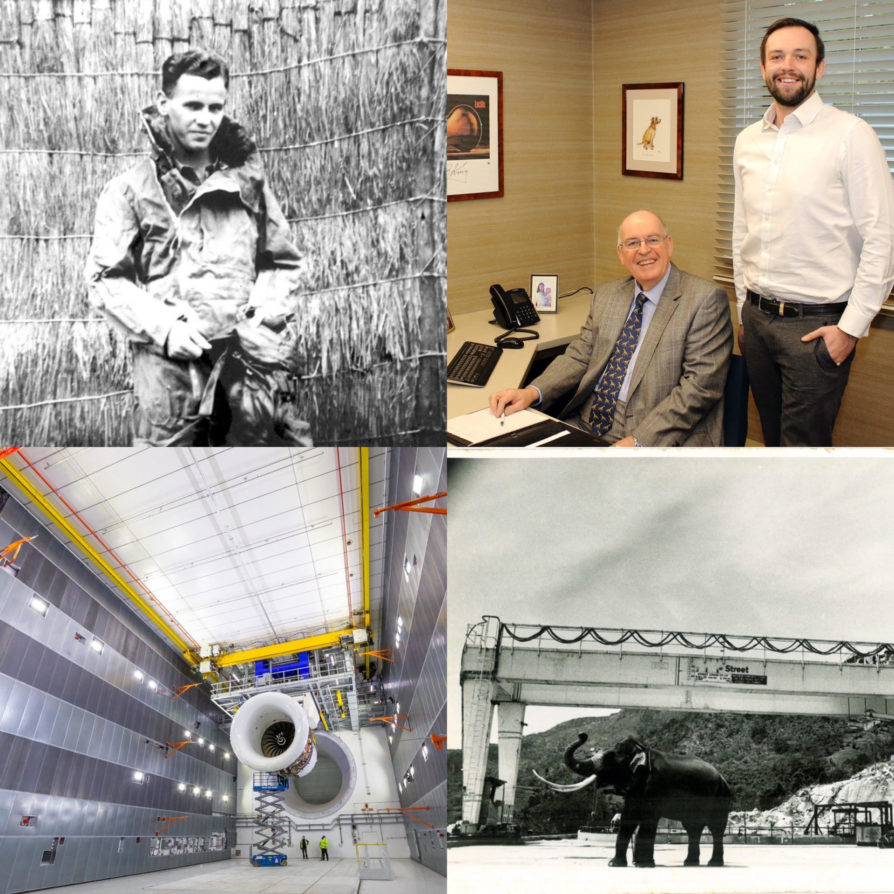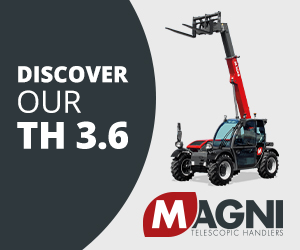)
Street’s ahead
Born out of a bombed‐out post war industrial landscape and currently riding‐out a world‐wide pandemic, as they turn 75, Street Crane share how a market driven approach adopted by their founder still inspires the company culture today and propels it forwards.
In 1946, when Peter R Street returned from the Second World War after flying Spitfires, Hurricanes and giant Horsa gliders, he had eighty‐eight Pounds Stirling in his pocket, given to him by the Royal Air Force as ‘gratuity’ for his service to the country. He decided to use the money to start a crane company in Sheffield, England, and the money bought the first company vehicle – a motorbike and side car, with which he set about servicing and repairing the neglected cranes in the local workshops.
Peter Street was a problem solver at heart, putting innovation at the very core of Street Crane’s success from the start. To make inroads into what was becoming a crowded market in the 1950’s, Peter set out to solve the problems others could not. For example post war material shortages meant the government allocated materials by strategic priority. Wound rotor motors used to give smooth acceleration on crane travel motions and vital to preventing uncontrollable load swings were difficult to procure. Peter solved this supply dilemma by employing fluid couplings and freely available four‐pole motors. This simple but effective fix meant Street could offer equal or even smoother crane acceleration at lower prices and shorter lead times that their competitors.
Achieving super smooth acceleration using fluid drives attracted attention. Plate glass was in high demand and the industry needed to lift ever larger glass sheets onto cutting lines. Crane motion control was only part of the equation. Peter quickly recognised the need for and developed vacuum lifting devices for use on cranes to handle the fragile glass sheets. He went on to develop vacuum lifting devices for handling products ranging from marble slabs to portable building panels, taking the Street name into more and more industries.
Throughout the 50’s and 60’s, the company built on its successes. The current Street ZX hoist range is the sixth generation of hoisting equipment the company has designed and serially manufactured. Early generations started with the Street S4 open winch hoist in the 1950s, designed to meet the heavy‐duty needs of the steel industry. ‘Inchmiser’ monorail hoists followed in 1960s and 70s for ultra‐low headroom applications. Former managing director Andrew Pimblett, now Street Crane’s longest serving employee, remembers, “Looking back to when I joined in 1969, the contrast to those early years could not be greater. After the post war reconstruction boom years, it soon become clear that the 70’s were going to be rough ride.” The company had recently purchased a factory on its current site in the High Peak and was starting to expand its horizons. The oil crisis, structural changes in the economy and geo‐politics saw heavy industry spiral into decline and with it the UK crane market started shrink.
“There were over 60 crane manufacturers, each with their own technology. Herbert Morris, John Smiths of Keithley, Clark Chapman, Wellman Booth and so many more. Making it even tougher. European crane manufacturers were entering the UK market too. If you had told me then, that 50 years on, only Street Crane would survive in the UK as a volume crane and hoist manufacturer, I would not have believed it.”
The company continued to innovate and by the 1980’s Street was the UK’s top‐selling EOT (electric overhead travelling) crane brand. The decline of the domestic industrial base meant future growth would be difficult and global predators were poaching market share.
The decision was taken to move into volume hoist production and become a supplier of hoists to independent EOT crane manufactures around the world. The odds were not favourable. However, team Street had accumulated vast experience, talented engineers and management ingenuity. They found chinks in the armour of the multinationals. The international giants were taking business from smaller independents just as Street had seen them do in the UK. Perhaps most important, the small independents could not invest sufficiently in designing the more advanced hoists and controls increasingly demanded by industry. Instead, they often had to source them from the same multinationals who were their competitors.
Street recognised that the requirements to compete in this market are advanced hoists based on a modular design concept, with multiple models and variants made from a minimum number of components, and with fast assembly and delivery times. They also knew that trust would be key to winning over the independents. The first range of Street hoists to meet these world market needs was the NX hoist range, which had the motor inside the hoist drum to optimise hook approaches. The company built a new hoist works with a dedicated machine shop, flowline assembly, powder coating line and test cells.
Trust came from a promise never to enter international markets with whole cranes or set‐up crane manufacture in overseas territories.
Crane making remains central to the Street business model but supplying hoists and crane components to over 100 partner crane makers around the world now forms the bigger part of the company’s turnover. Street believes 75 years of experience and the progressive design evolution of their crane technology are what enables them to deliver the high levels of reliability demanded by this market.
The product development history at Street is one of multiple incremental steps through continuous investment and innovation. At times, up to 10% of the entire workforce is engaged in designing and developing new products. In the 1990s most leading crane brands designed ‘world hoists’ to comply with design standards from ISO, EU, USA, and others, at internationally competitive prices. Street Crane saw that the need to meet this world price point was driving all hoist designs to evolve into the same basic direction. Again, Street Crane seized the opportunity and set out to make their world hoist different. The ZX3 and ZX4 hoist range included a gearbox brake to hold the load safe in case the motor brakes would not. Competitor hoist designs had sacrificed easy access for checking the safety of key components. In contrast, the new Street ZX hoist provided improved access for inspecting gears by including a gearbox lid. Adding an external hoist brake allowed easy inspection or setting in minutes.
These and other features gave the hoists a lower cost of ownership. Though not the absolute lowest price product in the market, the ZX concept was so successful that sales volumes in the mid‐2000s started to outstrip production capacity. Street’s design team reengineered the hoist to promote greater volume production and incorporated emerging control technology including VFDs (variable frequency drives) and PLCs (programmable logic controllers). The result was the current ZX6, ZX8 and ZX10 ranges which rolled out between 2008 and 2014. The range of hoist models has continued to expand and evolve with new models due to be launched later this year and next.
Because of the continually increasing demand for the ZX hoist, Street invested £3 million in a new world‐class hoist production factory in 2014, with the capacity to assemble 3200 hoists per year based on single shift working. This was followed by a major project in 2016 to re‐equip and modernise the crane factory to the same high standards. Recently added is a new hoist drum production facility with the capability to machine drums up to 6m long and 950mm diameter.
Street’s relationship with its partners around the world means sharing experience strengthens both parties. Keeping independent crane makers and growing their numbers is key to future growth and protecting market share from multinationals. The company has always invested in software tools and the launch of “Eazycrane” in 2020 has been the biggest yet. Eazycrane, is an online crane configuration program which puts 75 years of Street Crane know‐how and expertise at the fingertips of distributors. Chris Russell, Street Crane technical director led the Eazycrane project and explains, “My team and I were tasked with delivering Eazycrane in time for our 75th birthday and I am delighted to say we went live with crane kit and components functionality last year and the full crane function in January 2021.”
Managing director Gus Zona said, “Successful companies must innovate and adapt to deliver what customers want, we listen carefully to those on the frontline owning and operating cranes and we find they want more than just the lowest price. They know lifetime cost of ownership is the smart measure, they want a high level of serviceability to reduce planned downtime and high reliability to avoid costly unplanned downtime.” He continued, “We also listen to what our distributors want, which is simply a better deal than they get from other hoist and component suppliers. Our distribution model is, therefore, sole distribution deals in given territories in which we do not compete. ZX hoists and Street crane kits are only available under the Street brand so distributors are assured there is no backdoor into their markets.”
“Had Peter Street survived he would have celebrated his 100th birthday in 2021 so we also have good reason to remember our founder and the generations of colleagues who did the groundwork upon which we are now building our future,” Gus concluded.
Underpinning the Street Crane history is its strong sense of family values. Peter’s eldest son Martin Street has been at the helm as chairman since 1996 and he provides an interesting insight into the company ethos. “I am often asked how we thrived in a market with so much competition, when so many failed. I put it down to ‘Brittelstand’ values, by which I mean we have much in common with the German Mittlestand of independent family‐owned engineering businesses about which much has been written. Family businesses can have significant advantages over publicly traded corporations and critically we are not beholden to the short‐termism of the markets. Street Crane has invested non‐stop over decades in product and software development to enable us to deliver the advanced lifting solutions the market demands. In a family business long‐term focus can be combined with an entrepreneurial ideology and we can make quick decisions when there is advantage to be gained. I like to think the generational continuity has helped us to build the vital ingredient of loyalty between the company and our great Street team of colleagues and business partners.” Martin’s son William who has a background in business finance, joined the company this year and enthused, “It is thrilling to have joined Street Crane. It is so special to join something your family helped build from the ashes of WWII. The challenges of the Covid pandemic are new but the brilliant extended family team throughout the Street works and our global partners are meeting it head on. I am sure, if my grandfather were here today, he would approve and be proud of everyone.”











